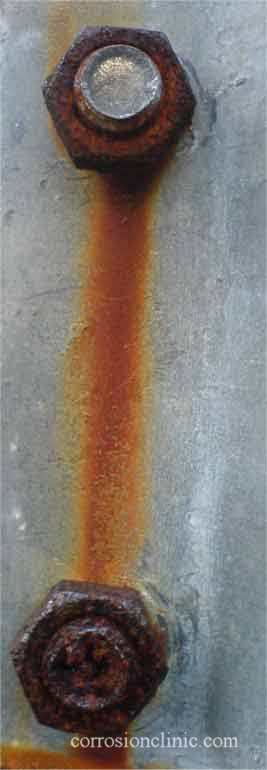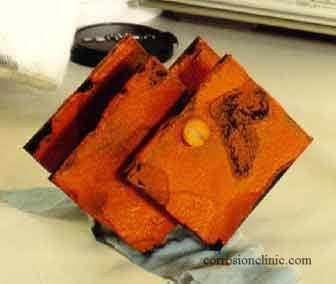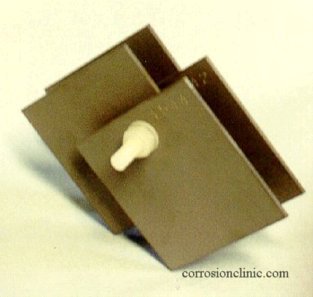|
|
|
|
• Uniform • Galvanic • Crevice • Pitting • Intergranular • MIC • SCC • HB-HE-HIC • Fatigue • Erosion • Fretting • Stray Current • Index |
|
Different Types of
Corrosion
|
|
Uniform Corrosion (General Corrosion) |
|
|
Recognition |
|
|
What is uniform corrosion?
Uniform corrosion or general corrosion, as sometimes
called, is defined as a type of corrosion attack (deterioration) that is
more or less uniformly distributed over the entire exposed surface of a
metal (see illustration below). Uniform corrosion also refers to the
corrosion that proceeds at approximately the same rate over the exposed
metal surface. Cast irons and steels corrode uniformly when exposed to open atmospheres, soils and natural waters, leading to the rusty appearance. The photo on the right showed uniform corrosion (rusting) of a pair of steel nuts used to fasten a galvanized steel clamp on a street lamp post. In sharp contrast, the galvanized steel clamp did not show any signs of corrosion but its surface was discolored by the rust. It is also interesting to note that the surface of the top bolt looked like galvanized but the surface of the bolt below was completely rusted (just like the nut). The photo (above, left) shows a steel coupon corroded (rusted) uniformly over its entire surface after immersion in oxygen aerated water while the same batch of coupons exposed to deaerated water (above, right) retained their metallic appearance with no visible corrosion (rust). In natural environment, oxygen is the primary cause of uniform corrosion of steels and other metals and alloys.
|
|
|
Mechanisms
|
|
|
What causes uniform corrosion? The anodic reaction in the corrosion process is always the oxidation reaction: M = M+ + e (1) In acidic environments, i.e., pH<7, the cathodic process is mainly the reduction of hydrogen ions: 2H+ + 2e = H2 (2) In alkaline or neutral environment, i.e., pH=7 or pH>7, reduction of dissolved oxygen is the predominant cathodic process that causes uniform corrosion: O2 + 2H2O + 4e = 4OH- (3) With uniform distribution of cathodic reactants over the
entire exposed metal surface, reactions (2) and/or (3) take place in a
"uniform" manner and there is no preferential site or location for cathodic
or anodic reaction. The cathodes and anodes are located randomly and
alternating with time. The end result is a more or less uniform loss of
dimension. |
|
|
Corrosion Prevention
|
|
How to prevent
uniform corrosion? Uniform corrosion or general
corrosion can be prevented
through a number of methods:
|
|
|
Corrosion
Modeling and Corrosion Prediction Software
|
|
|
General corrosion can be predicted using corrosion modeling and corrosion prediction software such as the following:
|
|
|
For more details on uniform corrosion
|
|
More details on Uniform Corrosion
or General Corrosion are included in the following corrosion courses which
you can take as
in-house training courses,
course-on-demand, online
courses or distance
learning courses:
If you require corrosion expert witness or corrosion consulting service on uniform corrosion, our NACE certified Corrosion Specialist is able to help. Contact us for a quote. |
|
|
Home | Subject Index | Contact Us | PDF |
Copyright © 1995-2024. All rights reserved. |


